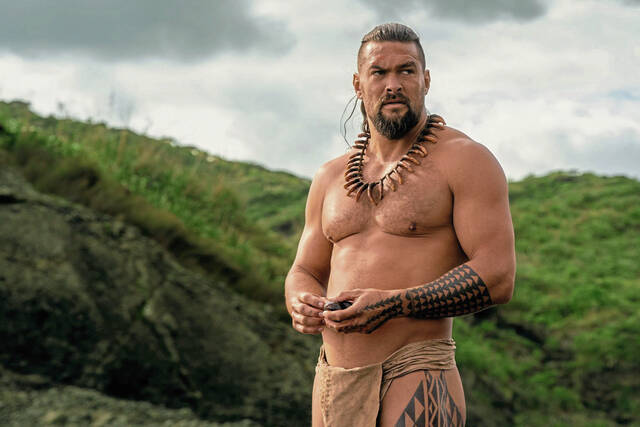https://triblive.com/aande/movies-tv/tv-talk-jason-momoas-chief-of-war-recounts-hawaiian-history/
TV Talk: Jason Momoa’s ‘Chief of War’ recounts Hawaiian history

Trib Total Media TV writer Rob Owen offers a viewing tip for the coming week.
The opening scene of Apple TV+’s Jason Momoa-starring “Chief of War” brings to mind Momoa’s “Aquaman” as he lassoes a shark. After that, this nine-episode historical fiction drama most resembles FX’s “Shogun.”
“Chief of War” streams its first two episodes Friday, then one episode per week on Fridays through Sept. 19.
Momoa co-created and co-wrote the premiere of “Chief of War” with showrunner Thomas Pa’a Sibbett (“Aquaman and the Lost Kingdom”), telling a story of the unification and colonization of Hawaii at the turn of the 18th century.
Momoa stars as Ka’iana, scion of a Hawaiian king. Ka’iana left his native island due to the bad leadership of his uncle, Kahekili (Temuera Morrison), Maui’s current king.
The suggestion that Ka’iana is the answer to the prophecy of one who will unite the island kingdoms of Ohau, Kauai, Maui and Hawaii leads Ka’iana back to serve his uncle when Kahekili tells Ka’iana his native land is about to be invaded.
Ka’iana suggests his homeland can be saved with “little bloodshed,” but no viewer who’s watched a Momoa movie will believe that’s how this will go. “Chief of War” gets to the violent confrontations the title suggests by the end of its first episode. Fair to say this one moves faster than “Shogun.”
But like “Shogun,” “Chief of War” mostly features characters speaking another language, in this case ‘Olelo Hawai‘i, and subtitled in English, at least in its first two episodes. (No English is spoken until Episode 2 when “pale skins” return to one of the islands.)
In an era when too many streaming series tell same-old, same-old true crime stories, “Chief of War,” which filmed in New Zealand and Hawaii, is inspired by real events rarely depicted in mainstream entertainment.
“Chief of War” co-creator Thomas Pa’a Sibbett said he briefly considered telling the story from the point of view of King Kamehameha, who ultimately became a secondary character in “Chief of War,” played by Kaina Makua. But Sibbett quickly decided that might prove too divisive because of the respect Hawaiians have for Kamehameha.
“In order to have your main character, you need to dirty him up, you need to expose their flaws, and you gotta run them through the dirt, and cover them with mud, and let them come out a hero and also fail,” Sibbett said in a Zoom interview last month. “If I were to do that with a character so beloved and well-documented as Kamehameha, then I would only be opening myself to criticisms and it just wasn’t worth it.”
Sibbett opted to tell the story of Hawaiian reunification through Momoa’s character.
“Shift the lens a little bit to the right, and you hit a man named Ka’iana, who was a world traveler,” Sibbett said. “He was the first Hawaiian chief to travel outside of Hawaii. That character is perfect for Jason.”
Sibbett acknowledged a need to balance historical accuracy with dramatic license in “Chief of War,” but he said much of what viewers might think is made up is real.
“The shark sequence, for example: It looks like a great way to start a movie. We’re in Hawaii, how can we show something unique? Jason is Aquaman,” Sibbett said. “But there are first-hand accounts of people witnessing Hawaiians riding sharks the way cowboys ride horses. If you know these things, if you have that in your bank, then when you write a story like this, you can cash it in.”
For “a hot minute,” Sibbett and Momoa considered making “Chief of War” a theatrical film but quickly decided it needed to be told as a long-form series, one that’s often been described as a “limited series,” but Sibbett said that’s not necessarily the case.
“Jason and I have never intended on this just staying a singular season, but we do know the responsibility that comes with this,” he said. “This is a story that’s never been told, and I don’t mean just the story. It is a culture, a language that has never been exposed to the world.
“We understand that there’s no demographic for it, there’s no market for it yet. But this is a universal story. This is not actually pitched as a Hawaiian story. It’s a really good story that just takes place in Hawaii. So let the culture be nuanced, let the costumes be beautiful texture. Let the language be something that you feel and experience for the first time.
“And if audiences can respond to that, then we absolutely will tell more, because the story only gets bigger. The story only gets better.”
Copyright ©2026— Trib Total Media, LLC (TribLIVE.com)
